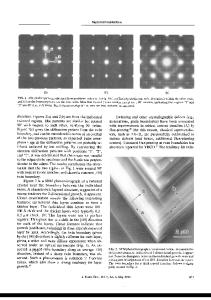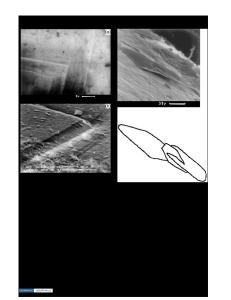Kinetic study of (Bi,Pb) 2 Sr 2 Ca 2 Cu 3 O 10+x phase formation in KCl flux
- PDF / 150,124 Bytes
- 5 Pages / 612 x 792 pts (letter) Page_size
- 36 Downloads / 338 Views
The kinetics of (Bi,Pb)2Sr2Ca2Cu3O10+x phase formation in KCl flux was studied, and kinetic analysis using the Avrami relation for isothermal phase transformation gave the Avrami exponent n ⳱ 2.5 at 855 °C for the whole process of (Bi,Pb)-2223 phase formation. The estimated value of the activation energy Ea ⳱ 150 kJ/mol for the formation of (Bi,Pb)-2223 phase at 845–855 °C is the lowest among the previously reported values. The low value of activation energy explains the fast formation of single-phase (Bi,Pb)-2223 powder in the KCl flux. I. INTRODUCTION
Since the discovery of the Bi2Sr2Ca2Cu3O10+x (Bi2223) phase with a superconducting transition temperature (Tc) of 110 K,1 it has been considered as one of the most promising compounds for practical applications. At the same time, it has been proved to be extremely difficult to synthesize a pure-phase Bi-2223. To increase the fraction of Bi-2223 phase in polycrystalline samples, various methods were proposed such as changing the composition ratio from 2:2:2:3,2–5 reducing oxygen partial pressure,6,7 using hot-pressing,8 utilizing homogeneous precursors,9,10 and optimizing reaction pathways.11,12 However, the phase purity did not exceed 80–90% and the intergrowth of Bi2Sr2Ca1Cu2O8+x phase (Bi-2212) together with (CaSr)2CuO3 and CuO impurities phases still remained. Partial substitution of Bi by Pb has proved to be the most effective way to stabilize the 2223 phase and accelerate phase formation.13,14 However, even the (Bi,Pb)-2223 phase formation is sluggish and the formation of a single or nearly single phase usually involves 50–100 h of heat treatment with intermediate grindings. At present, many studies dealing with 2223 phase formation have been published and several mechanisms were suggested.15–20 The kinetics of the (Bi,Pb)-2223 phase formation was also studied by several groups using glass, powder, and Ag-clad samples.21–31 The kinetic analysis was performed using the Avrami relation for isothermal phase transformations.32 It was shown that most of the kinetic data can be well described within a framework of the diffusion-controlled transformation model. However, the reported values of Avrami exponent (n) and activation energy (Ea) for the formation of the (Bi,Pb)-2223 phase are distributed over a very wide range (e.g., 0.5 < n < 1.7 and 460 < E a < 2100 kJ/ mol).21–31 It was pointed out that the Ea value may depend on the experimental conditions, such as heating rate, equilibration time, precursor, etc.31 J. Mater. Res., Vol. 17, No. 9, Sep 2002
http://journals.cambridge.org
Downloaded: 14 Mar 2015
The problem is that even the lowest value reported of Ea ⳱ 460 kJ/mol is too large for a simple diffusion process. Since activation energies larger than 100 kJ/mol are unprecedented for such processes, the obtained values of Ea were considered as the “apparent” activation energies for the 2223 formation process involving a collective series of parallel reactions.28 Thus, determination of the actual value of Ea for the formation of the (Bi,Pb)-2223 phase is still
Data Loading...











